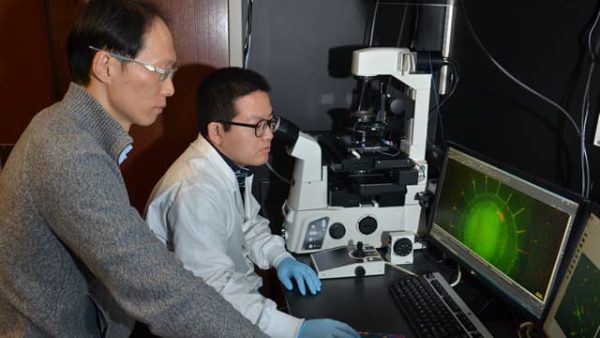Brain-on-chip research mimics brain function

With hundreds of billions of neurons and thousands of trillions of synaptic connections between them, the human brain is considered the most complex system on earth. This complexity makes studying the brain an almost overwhelming challenge with nearly infinite research options.
“Unfortunately, there are no well-developed brain models to study the brain activities in either laboratory environments or in animal bodies,” said Hansang Cho, assistant professor of mechanical engineering in the Lee College of Engineering. “It is hard to regulate and perform image scans of the brain, because their functions are too complicated to interpret, and the skull is too thick to image through. My interest is in developing micro-scaled environments that allow us to reconstruct specific brain functions and nano-scaled technologies to measure them.”
To systematize research components into elements that can be understood on their own or in conjunction with one another, Cho and his research team have developed innovative brain-on-chip devices and monitoring nanotechnologies. Brain-on-chip essentially means micro-scaled platforms that mimic brain functions and allow for unobstructed observations on small, controllable devices. As a mechanical engineer, Cho has expertise in building such devices that has led to in-depth research and achieved high-impact international publication about three types of brain chips covering most of brain activities.
Cho’s research group is part of the Center for Biomedical Engineering and Science at UNC Charlotte. His work is currently funded by the Cure Alzheimer Fund and the Charlotte Research Institute. The research team includes five undergraduate students, one graduate student, two post-doctoral fellows and one visiting professor.
“There are major causes of neurological disorders we are looking into,” Cho said. “These include the overexpression of biological reagents, which leads to the activation of immune responses inside brains. Our immune system in the brains tries to clear these reagents at a toxic level, but at the same time also kills cells that are inhibiting normal brain functions while trying to save the whole brain system at the expense of sacrificing some brain cells. But through the accumulation of the toxic reagents over ages, brains are continually losing functions and eventually obtain neurodegenerative disorders, dementia including Alzheimer’s disease (AD) and Parkinson’s disease (PD).”
The team is using its brain-on-chip platforms to culture brain cells, which reconstruct specific brain functions. Medical school researchers from Harvard, Yale, University of Southern California and Rutgers University are providing brain cell materials for testing; Seoul National University Hospital, Korean University Hospital and Clemson University are collaborating. “They are sharing their knowledge and providing the biological material,” Cho said.
The three brain models that Cho’s team recently developed were designed to measure microglia cell activity in AD environments, construct 3D blood-brain barriers for neurovascular disorders and investigate how neurotoxic Tau proteins to propagate in AD progression.
“We fabricated a microfluidic platform that provides precise spatial and temporal control of chemokine (chemical attractant) gradients by using photo lithographic techniques. After, we coated the platform with cellular adhesive reagents to promote cellular growth and activation,” Cho said. “In the microglia study, we grew human microglia, imaged and measured their migration activities responding to various conditions of neurotoxic amyloid-beta peptides in arrayed platforms at a single cellular resolution, real-time measurement and a high throughput. It is very simple but very controllable.”
For more information, see the Nature article “Microfluidic Chemotaxis Platform for Differentiating the Roles of Soluble and Bound Amyloid-β on Microglial Accumulation.”
Click here to read more about this research.